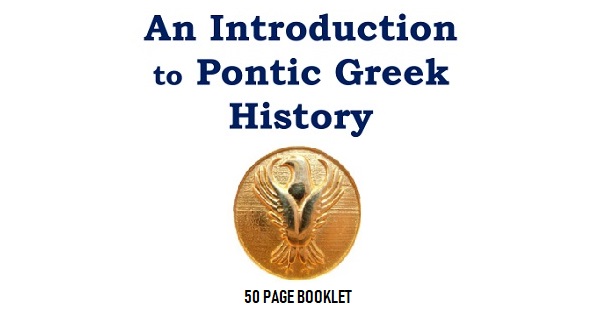
View and download part II here
This booklet is a brief introduction to Pontic Greek history for those who are not interested in reading detailed work on this topic. My aim is to produce a well-researched work in English on Pontos to pass onto our youth. In this booklet I use the word ‘Pontic’, the academically accepted term in English for people from Pontos. All the many academic references are included at the end of the booklet.
My many more detailed articles on Pontic history and culture can be found at least on the excellent PontosWorld website here. My book, Topalidis (2007), A Pontic Greek History, can be found in some libraries. I have referred often to the landmark research by Professor Anthony Bryer, the great doyen of Pontic history. For those who can read Greek, I recommend the excellent work by Dr Vlasis Agtzidis.
In this booklet, the first three chapters give an outline of who are Pontic Greeks, where they came from and where they were relocated. Chapters four to seven cover the history of four Pontic settlements: Sinope, Trabzon, Samsun and Gümüshane, the famous silver mining centre of the Ottoman empire. Chapters eight to 12 describe five of the many famous former churches or monasteries in or around Trabzon which I visited in 2018.
Chapter 13, on ‘The Pontic Greek Dialect’, describes when Pontos became isolated from other Greek speaking areas its Greek language maintained many old characteristics which have now been lost in Demotic Greek. Chapter 14, ‘Trabzon Metropolitan Chrysanthos’ describes the man who protected his Greek flock but who also assisted Turkish refugees during World War I. Chapter 15 on the history of ‘The Single- and Double-Headed Eagle Symbols in Pontos’, looks at the importance of these symbols to Pontic Greeks.
Chapter 16 summarises the significance of the Greek Crypto-Christians. These people were openly Muslim but maintained their Christian beliefs at home. Chapter 17 briefly describes the Pontic ‘Family History of Sofia Dimarhos’. What a story! I warmly thank Sofia for allowing me to interview her several times and for the extra weight I gained as she force-fed me. The final chapter, ‘Where to From Here?’ points us to what we can do to foster Pontic history and culture for the coming generation.
We should be in awe of the courage shown by our Pontic ancestors in defending their families, their Christian religion and Greek culture. They were great survivors. May we stand upon their shoulders so we can see further. -Sam Topalidis
Chapters
1. Who are the Greeks from Pontos?
2. Formation of the Greek Settlements in Pontos
3. The Relocation of Greeks From Pontos
4. History of Sinope
5. History of Trabzon
6. History of Samsun
7. History of Gümüshane
8. Former Panagia Theoskepastos Monastery, Trabzon
9. St Anne Church, Trabzon
10. Former Panagia Chrysokephalos Church, Trabzon — now Fatih Mosque
11. Former St Sophia Church, Trabzon — now Ayasofya Mosque
12. The Soumela Monastery
13. The Pontic Greek Dialect
14. Trabzon Metropolitan Chrysanthos
15. The Single and Double-Headed Eagle Symbols in Pontos
16. Greek Crypto-Christians in Pontos
17. Family History of Sofia Dimarhos
18. What to From Here?
19. References
